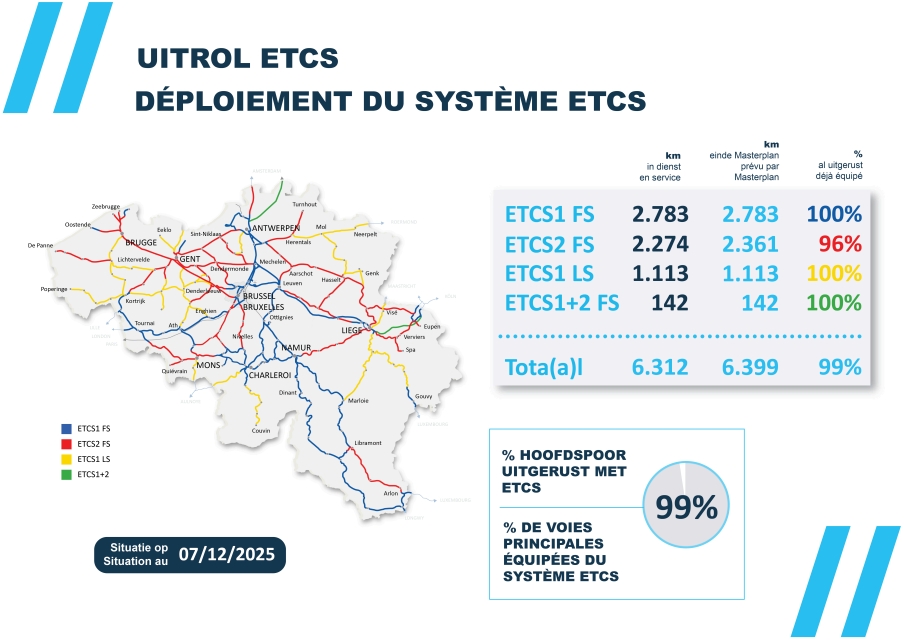What is ETCS?
ETCS is an automatic safety system that greatly reduces the risk of a train passing a red signal. Excessive speed, which is the cause of many train accidents, is also made virtually impossible. Both the train and the infrastructure shall be equipped with ETCS.
ETCS stands for European Train Control System. This European system enables trains from other European countries to travel safely also on our network.
ETCS 1 Limited Supervision: the train receives signalling and speed information from beacons placed along the track. The information is not displayed on board the train. The driver must follow the signals along the tracks.
ETCS 1 Full Supervision: the train receives signalling and speed information from beacons placed along the track. The driver can view all the information on their screen.
ETCS 2 Full Supervision: information about signals and the speed limit no longer comes from beacons along the route, but from GSM-R masts installed along the track. The train driver can rely on the information provided continuously in their cab.
ETCS 1 +2 Full Supervision: the train driver receives signal and speed information in their cab. The information comes either from GSM-R masts or from beacons. This system has been installed on high-speed lines 3 (to Germany) and 4 (to the Netherlands).
What is the ETCS Masterplan?
We have an ETCS Masterplan, which aims to roll out ETCS step by step across the entire rail network. The target is that, by the end of 2025, all trains in Belgium will be using ETCS. Between now and then, we need to equip the entire infrastructure with ETCS. The Masterplan indicates which railway lines will be equipped with ETCS, and at what level. There are several different levels of ETCS. We have chosen to implement a combination of ETCS Level 1 Full Supervision, ETCS Level 1 Limited Supervision and ETCS Level 2 Full Supervision on the Belgian network.
- ETCS Level 1 Full Supervision:
- Deployment on Corridor C (freight route from the port of Antwerp via Leuven and Namur to Athus)
- Deployment on line 10 and line 36C/2
- Deployment on Ans-Angleur section of line 36/37
- ETCS Level 2 Full Supervision:
- Deployment of a generic design, including the Deinze-Waregem pilot line
- Deployment on line 12, Kapellen-Essen section
- Deployment on line 162, Libramont-Autelbas section
- Deployment on line 59, Beveren-Berchem section
- Deployment on line 16, Lier-Aarschot section
- Deployment on line 50A, Bruges-Gent-Sint-Pieters section
Co-funded by the European Union
The European Union is supporting the implementation of ETCS on the Belgian rail network by granting us several subsidies.


The contents of this publication are the sole responsibility of Infrabel and do not necessarily reflect the opinion of the European Union.

Deployment of the ETCS system
As of December 8, 2025:
ETCS1 FS: 2,783 km in service out of the 2,783 km scheduled in the Masterplan, i.e. 100% already equipped
ETCS2 FS: 2,274km in service out of the 2,361 km scheduled in the Masterplan, i.e. 96% already equipped
ETCS1 LS: 1,113 km in service out of the 1,113 km scheduled in the Masterplan, i.e. 100% already equipped
ETCS1+2 FS: 142 km in service out of the 142 km scheduled in the Masterplan, i.e. 100% already equipped
Total: 6,178 km in service out of the 6,399 km scheduled in the Masterplan, i.e. 97% already equipped
